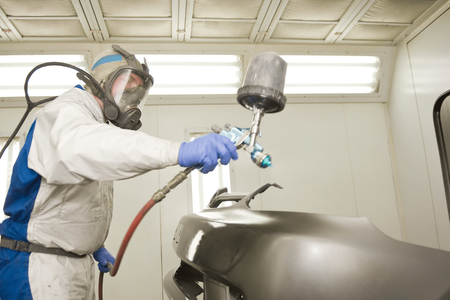Air Compressor Dryer Hacks for Cleaner, Smoother Painting Every Time
 SuperDry Systems
01 Aug, 2025
9 mins read
14
SuperDry Systems
01 Aug, 2025
9 mins read
14

When it comes to achieving a flawless paint job—whether you're working on cars, furniture, or walls—moisture in your compressed air is the silent enemy. Blisters, fisheyes, and uneven textures often stem from one overlooked component: air quality. That’s where an air compressor dryer for painting becomes a game-changer. By removing moisture and contaminants before they reach your spray gun, you ensure a cleaner and smoother finish every time. But owning a dryer isn’t enough—knowing how to use and optimize it can elevate your results dramatically.
In this article, we’ll walk through essential hacks and expert tips to help you get the most out of your air compressor dryer setup.
Understand the Role of the Air Compressor Dryer in Painting
Before diving into the hacks, it’s important to grasp why a dryer is vital in any spray painting setup. Air from a compressor naturally contains moisture—especially if you live in a humid climate or your compressor runs for long periods. As this air travels to your spray gun, it carries moisture droplets that can contaminate your paint, causing bubbling, poor adhesion, or uneven application.
An air compressor dryer for painting eliminates this moisture before it enters the spray line. The result is clean, dry air that helps paint atomize properly and adhere smoothly, giving you a high-quality finish that lasts.
Choose the Right Type of Dryer for Your Needs
Not all dryers are created equal. The two main types used in painting applications are desiccant dryers and refrigerated dryers. Desiccant dryers absorb moisture using drying agents like silica gel, and they’re excellent for low-volume, intermittent jobs. Refrigerated dryers cool the air to condense moisture out and are better suited for continuous, high-volume work.
If you’re a hobbyist doing small projects occasionally, a desiccant dryer may be ideal. For automotive or commercial-level painting, a refrigerated dryer offers consistency and efficiency. Matching your dryer type to your workflow will make all the difference.
Install Water Separators and Filters Before the Dryer
While the dryer is the hero of moisture removal, it shouldn’t work alone. Installing a water separator and a particulate filter upstream from your air compressor dryer ensures that excess liquid and debris are removed before the air even reaches the dryer. This pre-filtration reduces the burden on the dryer and extends its lifespan.
Using a combination of moisture traps and filters at different stages (at the compressor, the dryer, and near the spray gun) provides multiple layers of protection, resulting in ultra-clean air delivery.
Monitor and Maintain Your Dryer Regularly
Even the best dryer won't perform well if neglected. Regular maintenance is key. If you’re using a desiccant dryer, be sure to monitor the saturation level of the desiccant beads—they change color when it’s time for a replacement. Refrigerated dryers require periodic inspection to ensure cooling coils are functioning and drainage systems are unclogged.
Don’t forget to drain your air tank daily and check for rust or oil buildup, as both can work their way into the air stream and affect your final paint job.
Keep Hose Lines Short and Cool
Air travels through your hose lines before reaching the spray gun, and the longer or hotter those lines are, the more condensation can form. This can partially defeat the purpose of having a high-quality dryer. Use short, high-quality hoses, and avoid routing them across hot surfaces or near equipment that radiates heat.
Adding a coalescing filter close to your spray gun also helps catch any last-minute moisture or oil before it touches the paint.
Use Regulated Air Pressure with Dry Air
Proper air pressure is crucial in painting, and combining that with moisture-free air gives you unmatched results. Make sure your regulator is installed after the dryer system so that it controls only clean, dry air. This ensures more consistent atomization and prevents spurts of wet air from compromising your spray pattern.
Also, always check the pressure requirements for your specific spray gun and type of paint. Too much pressure can atomize paint too finely, while too little can cause splatter or orange peel texture.
Warm-Up Time Matters
Turning on your compressor and instantly starting your spray session is tempting—but it’s not ideal. Give your compressor and dryer a few minutes to stabilize, especially in colder environments. A short warm-up period allows condensation to be expelled early, prevents water from entering your lines, and helps the dryer system perform more effectively.
Starting your project with stabilized, moisture-free air is better than troubleshooting defects after the fact.
Keep a Close Eye on Environmental Conditions
Humidity and temperature affect how much moisture your compressor pulls in from the air. During hot or humid days, your dryer works harder, and any weakness in your system can be exposed. If you paint frequently, consider investing in a digital humidity monitor to track air moisture levels in your workspace.
This allows you to adjust drying capacity or delay your project until conditions are more favorable—saving both your time and materials.
Test Spray Before Every Job
Even with a perfect dryer setup, it's wise to test your air output on a scrap piece before spraying your actual work surface. A quick test lets you spot any signs of moisture, such as sputtering or uneven spray, and make adjustments before it’s too late.
This habit becomes especially valuable when changing locations, spray guns, or compressors—every setup is a little different, and consistent testing keeps you in control.
Conclusion:
A clean, smooth paint job doesn’t just come from good paint or technique—it starts with the air itself. Using an air compressor dryer for painting is one of the smartest upgrades you can make, but it’s even more powerful when combined with smart usage, maintenance, and environment awareness.
By applying the hacks above—such as using multiple filters, managing hose conditions, and maintaining your dryer—you’re setting yourself up for consistent, pro-level results every time you pick up the spray gun.
Written By:
SuperDry Systems



Hotels at your convenience
Now choose your stay according to your preference. From finding a place for your dream destination or a mere weekend getaway to business accommodations or brief stay, we have got you covered. Explore hotels as per your mood.





